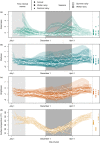Remotely sensed environmental measurements detect decoupled processes driving population dynamics at contrasting scales
- PMID: 37539069
- PMCID: PMC10396668
- DOI: 10.1002/ece3.10358
Remotely sensed environmental measurements detect decoupled processes driving population dynamics at contrasting scales
Abstract
The increasing availability of satellite imagery has supported a rapid expansion in forward-looking studies seeking to track and predict how climate change will influence wild population dynamics. However, these data can also be used in retrospect to provide additional context for historical data in the absence of contemporaneous environmental measurements. We used 167 Landsat-5 Thematic Mapper (TM) images spanning 13 years to identify environmental drivers of fitness and population size in a well-characterized population of banner-tailed kangaroo rats (Dipodomys spectabilis) in the southwestern United States. We found evidence of two decoupled processes that may be driving population dynamics in opposing directions over distinct time frames. Specifically, increasing mean surface temperature corresponded to increased individual fitness, where fitness is defined as the number of offspring produced by a single individual. This result contrasts with our findings for population size, where increasing surface temperature led to decreased numbers of active mounds. These relationships between surface temperature and (i) individual fitness and (ii) population size would not have been identified in the absence of remotely sensed data, indicating that such information can be used to test existing hypotheses and generate new ecological predictions regarding fitness at multiple spatial scales and degrees of sampling effort. To our knowledge, this study is the first to directly link remotely sensed environmental data to individual fitness in a nearly exhaustively sampled population, opening a new avenue for incorporating remote sensing data into eco-evolutionary studies.
Keywords: Landsat; fitness; monitoring; population dynamics.
© 2023 The Authors. Ecology and Evolution published by John Wiley & Sons Ltd.
Figures











Similar articles
-
Assessment and statistical modeling of the relationship between remotely sensed aerosol optical depth and PM2.5 in the eastern United States.Res Rep Health Eff Inst. 2012 May;(167):5-83; discussion 85-91. Res Rep Health Eff Inst. 2012. PMID: 22838153
-
Opportunities for the application of advanced remotely-sensed data in ecological studies of terrestrial animal movement.Mov Ecol. 2015 May 4;3(1):8. doi: 10.1186/s40462-015-0036-7. eCollection 2015. Mov Ecol. 2015. PMID: 25941571 Free PMC article.
-
Assessing the potential of remote sensing-based models to predict old-growth forests on large spatiotemporal scales.J Environ Manage. 2024 Feb;351:119865. doi: 10.1016/j.jenvman.2023.119865. Epub 2023 Dec 29. J Environ Manage. 2024. PMID: 38159307
-
Long-term oceanographic and ecological research in the Western English Channel.Adv Mar Biol. 2005;47:1-105. doi: 10.1016/S0065-2881(04)47001-1. Adv Mar Biol. 2005. PMID: 15596166 Review.
-
Scaling up functional traits for ecosystem services with remote sensing: concepts and methods.Ecol Evol. 2016 Jun 2;6(13):4359-71. doi: 10.1002/ece3.2201. eCollection 2016 Jul. Ecol Evol. 2016. PMID: 27386081 Free PMC article. Review.
References
-
- Adams, D. K. , & Comrie, A. C. (1997). The north American monsoon. Bulletin of the American Meteorological Society, 78(10), 2197–2213.
-
- Albright, T. P. , Pidgeon, A. M. , Rittenhouse, C. D. , Clayton, M. K. , Flather, C. H. , Culbert, P. D. , & Radeloff, V. C. (2011). Heat waves measured with MODIS land surface temperature data predict changes in avian community structure. Remote Sensing of Environment, 115(1), 245–254. 10.1016/j.rse.2010.08.024 - DOI
-
- Allnutt, T. F. , Wettengel, W. W. , Valdés Reyna, J. , de Leon Garcia, R. C. , Iñigo Elias, E. E. , & Olson, D. M. (2002). The efficacy of TM satellite imagery for rapid assessment of Chihuahuan xeric habitat intactness for ecoregion‐scale conservation planning. Journal of Arid Environments, 52(1), 135–153. 10.1016/S0140-1963(01)90984-X - DOI
-
- Bankert, A. R. , Strasser, E. H. , Burch, C. G. , & Correll, M. D. (2021). An open‐source approach to characterizing Chihuahuan Desert vegetation communities using object‐based image analysis. Journal of Arid Environments, 188, 104383. 10.1016/j.jaridenv.2020.104383 - DOI
-
- Bateman, H. L. , Allen, B. D. , Moore, M. S. , & Hondula, D. M. (2023). Urban heat and desert wildlife: Rodent body condition across a gradient of surface temperatures. Urban Ecosystem. 10.1007/s11252-023-01358-4 - DOI
Associated data
LinkOut - more resources
Full Text Sources

